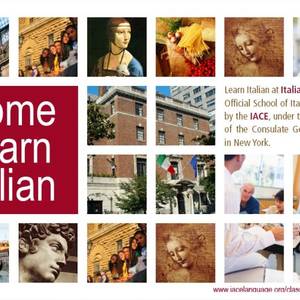On 2nd Saturday, December 12, IAWA will premiere its first Student Partners Reading featuring recent graduates from New Jersey City University (NJCU): Cassandra Casella, Chloe DeFilippis and Angelica Roman. IAWA plans to make this an ongoing program to foster mentor relationships and encourage young writers to read out loud.
You chose: new jersey
-
-
Events: ReportsThe Italian American Writers Association will celebrate its 25th Anniversary in 2016. Readings begin with an Open Mic; IAWA-East is held even months at Sidewalk Café and IAWA-West continues at Cornelia Street Café on odd months.
-
Take a break and check out this new establishment in Union Square serving lunch, dinner, snacks, coffee and cocktails. The service may be quick but the place is still authentically Italian.
-
Italian language and Italian culture make an inseparable pair. Ilaria Costa, executive director of the Italian American Committee on Education (IACE), speaks about this and recounts how difficult it is, in the Tristate area, to promote everything Italian through the language. It’s surprising – but not surprising to us at i-Italy – that many Americans, who do not have a familial relationship with our country, are interested in studying our language. The charm of our culture penetrates America, regardless of the blood ties of its inhabitants.
-
-
At age fourteen I defended us against the black mafia and experienced my dad's love.
-
This year’s celebration of the Feast of the Republic in Newark constituted the occasion for the Italian and Italian-American community in New Jersey to wish farewell to Consul General of Italy in Newark Andrea Barbaria. After four years of service in Newark, Barbaria has been assigned to the Mission of Italy in Tehran, Iran.
-
-
On Saturday, October 16th, from 3pm - 5pm, the IIC LA will host a screening of THE BASEMENT with the film's Producers, Darrell Fusaro and Jeff Trujillo, in attendance. The event is part of of this year's HitWeek 2010!
-
Facts & StoriesOn March 26th, the front page of The New York Times online edition presented the case of the "Our Lady Of Loreto" church in Brooklyn. Residents have long been fighting the decision of the Diocese to demolish this historical monument, built by Italian immigrants in the early 1900s, in order to build in its place low income housing. We had published a story in January 2009, suggesting that the NYT look into it more closely. Our article, written by Joey Skee, reviewed the issue giving plenty of historical and cultural detail; it also hinted that the weakness of the local residents' protest could be explained not only in ethnic-political terms (that is, as a sign of weakness of the Italian American community) but also as the consequence of low rates of church attendance by the local Catholics – the majority of whom now are Latinos, Haitian Americans, and others. Over the years, this led to the site’s increasing disuse, which "transformed it into a dead place, a spent memorial to an Italian-American past." Now that the Italian-American and African-American communities are joining forces in their protest to convert the church into a much needed neighborhood cultural center, we believe that is incumbent on all of us to gather our resources. In so doing, we have decided to re-publish our previous article together with a Facebook message from Senator Diane Savino urging everybody to join the battle.







































